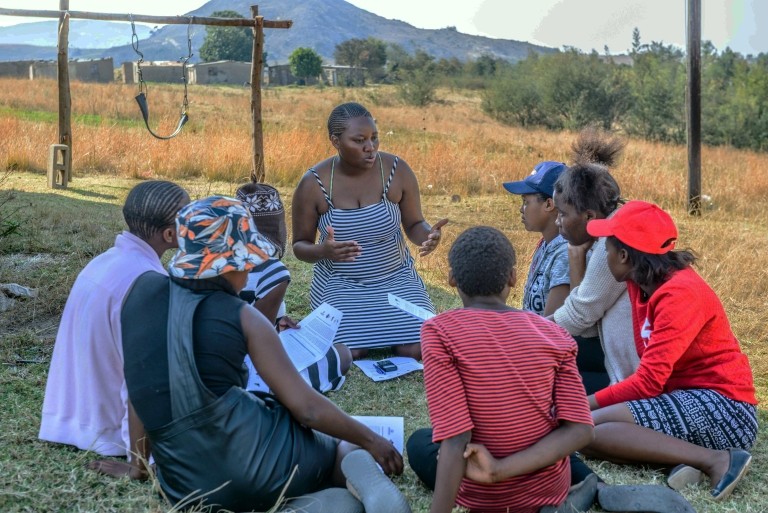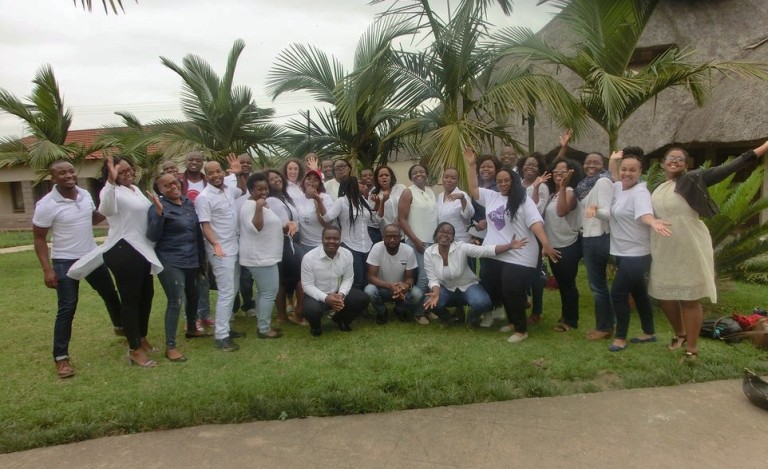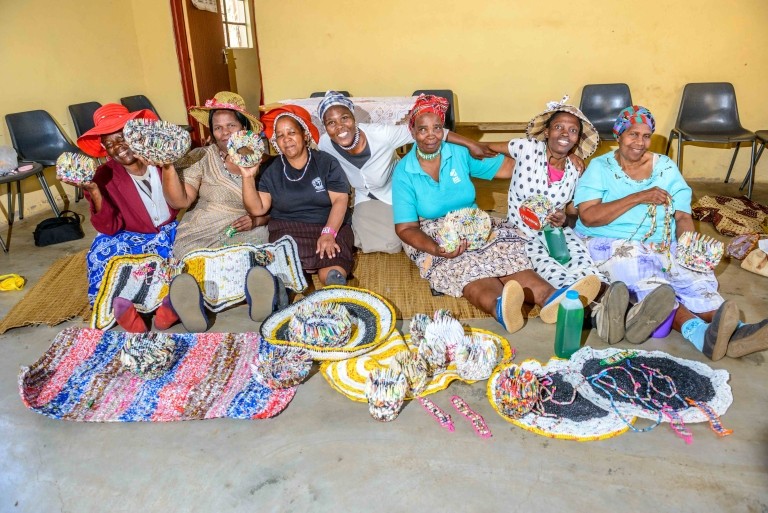Feature
In Eswatini, two local Pact partners make a huge leap forward as they ‘graduate’ to direct USAID funding

In the beginning, Khulekani Magongo recalls, it was just him and a Peace Corps volunteer. It was 2006, and Magongo was the sole employee of Young Heroes, a Swazi organization that launched to respond to the country’s desperate HIV and AIDS crisis.
Eswatini – then known as Swaziland – is a tiny landlocked country of about 1 million people, and it has long had one of the highest HIV rates in the world. Young Heroes was formed as a project of the country’s National Emergency Response Council on HIV and AIDS. Over the years, it grew, but slowly. By the time Young Heroes registered as a standalone NGO in 2014, it still had fewer than a dozen staff. It focused on responding to HIV and AIDS as well as other work that improved the lives of vulnerable youth in Eswatini by empowering them.
It was around this time that Young Heroes and Pact began working together.
“That’s when it really began to change for us,” says Magongo. He remains at the helm of Young Heroes, but today he leads a staff of more than 50 working across four districts, and his organization recently reached a major milestone: In December, for the first time, Young Heroes was awarded funding directly from the U.S. Agency for International Development in Eswatini, along with another local Pact partner, World Vision Eswatini.

It’s an achievement that Magongo says he sometimes still can’t believe – and one that is at the heart of USAID’s and Pact’s philosophy on how international development should be done. For decades, Pact has worked to develop the capacity of local organizations around the world so that they are well equipped and resourced to solve development challenges in their own communities, from health crises to poverty to environmental problems. Pact starts by helping our local partners to explore their strengths and weaknesses using proven assessment tools and approaches. Then we jointly create action plans to strengthen their performance in administration, HR, finance, program design and delivery and more. Pact provides training and mentorship along the way.
“We develop local capacity because it is the best way to empower communities to lead their own development, building resilience for positive social change that lasts,” says Ebele Achor, Pact’s capacity development director. “Besides mentoring local organizations, we provide them with sub-grants that Pact funds through larger awards from international donors like USAID.”
Achor notes that a pinnacle achievement in capacity development for Pact is taking itself out of the equation by strengthening a local organization to the point that it is qualified to win funding directly from international aid agencies and continue on effectively without Pact’s support. This is also a major priority for USAID, as demonstrated by its Journey to Self-Reliance strategy, which focuses on creating sustainable development results so that foreign assistance eventually will no longer be necessary.
“For Pact, graduating our local partners to direct USAID funding is one of our proudest achievements,” Achor says, “because it is such a significant step on that path to self-reliance and to development that is truly locally led.”
Along with Young Heroes, Pact began working in 2019 to transition one other local partner in Eswatini to direct USAID funding – World Vision Eswatini. Pact started partnering with both local organizations in 2015 through the USAID and PEPFAR-funded Community Rapid and Effective Action Combating HIV/AIDS (REACH) III program. Young Heroes and World Vision Eswatini each had experience in youth HIV programming, but they also had plenty of room to grow and improve organizationally. Pact provided them targeted capacity development support as they delivered services to local communities with Pact’s guidance under REACH III.
The partnerships continued when Pact was awarded USAID and PEPFAR’s follow-on project, Insika Ya Kusasa, a five-year effort that is working to reduce new HIV infections and improve HIV clinical outcomes among two groups that are key in the fight against AIDS: adolescent girls and young women (AGYW) and orphans and vulnerable children (OVC).
“We need this kind of organizational growth in Eswatini so that we are truly taking the lead.” –Khulekani Magongo
As Insika Ya Kusasa progressed, USAID and Pact agreed that the project was well suited for transitioning local partners to direct USAID funding. Pact had 11 local partners at the time under Insika, says Pact’s Nosipho Storer, the project’s deputy chief of party.
“We looked very closely at their familiarity with OVC programming and their ability to manage funds,” Storer says. “Out of our 11 partners, Young Heroes and World Vision Eswatini performed the strongest. They had good management systems in place with well-articulated responsibilities, and they both had a lot of trust and credibility with local communities.”
The process to prepare Young Heroes and World Vision Eswatini to apply for upcoming USAID awards was built on Pact’s existing capacity development approach, but it was far more intensive. “We developed a new tool, the Transition Readiness Plan, with a baseline analysis, and then we used the tool to track their progress systematically,” Storer explains. “We identified every weakness and then worked on each one on a set timeline. Sometimes our whole team would meet with theirs, and other times our staff would work one-on-one with their counterpart at the local partner.”
“We had to ensure that we were continuing to implement Insika to the highest standards while also improving ourselves and our systems to USAID expectations,” says Young Heroes’ Magongo. “It was two very big jobs at once.”
World Vision Eswatini’s Happiness Mkhatshwa notes that all of this was taking place as development programs around the world were figuring out how to adapt to Covid-19. “It was such a learning curve,” she says.
Storer was continually impressed with the partners’ dedication. “In the beginning it was so daunting. They knew they wanted this, but we truly weren’t sure whether we would be successful in the end, so it was a risk. I was so humbled by their commitment to the process and their willingness to go above and beyond in every aspect.”
When it came time to prepare their proposals for USAID prime awards, the work intensified even more, with Pact providing daily peer-to-peer support to meet tight deadlines. When the partners learned that they both had won the USAID awards they applied for, they celebrated with Pact via video and phone calls. “We couldn’t be together because of Covid-19, but we were all cheering in our houses,” Storer says. “It is certainly one of the highlights of my career.”

Under the awards – about $4.4 million for Young Heroes and $5.2 million for World Vision Eswatini – the organizations will provide HIV prevention programming for vulnerable children and adolescent girls and young women for three years, including household-level case management for OVC and their caregivers and DREAMS programming for AGYW. Pact will continue to provide dedicated support to Young Heroes and World Vision Eswatini for at least the first year to ensure their success.
Everyone involved says they learned tremendously through the process. Magongo says Young Heroes learned just how critical it is to have strong organizational systems in place. Storer says Pact will take so many lessons into its future work to transition local partners to direct funding, foremost that the process must be driven by a partner’s desire.
“Pact can guide them every step of the way, but they have to want it and lead it,” she says.
And all say the hard work is worth it.
“If we are doing capacity development work, then we should be graduating local partners to prime funding,” Storer says. “To me, at least on the organizational level, this is the epitome of what Pact does. It shows that capacity development works, and that we really are helping local communities to own their future.”
Nicole Miller, Pact’s Eswatini country director, says this is especially important at this stage in Eswatini’s fight to end AIDS. “We are achieving HIV epidemic control, an achievement few thought possible ten years ago,” Miller says. “With this comes an incredible responsibility: sustaining epidemic control. A strengthened civil society ready and well-equipped to be leaders in community HIV service delivery is key to sustaining the important gains made in the country.”

The benefits for those served by World Vision Eswatini are significant, Mkhatshwa notes. “Local organizations are the ones that are there on the ground, among our constituencies. We know their needs, because we are a part of them. It is the key to sustainable improvement.”
Thinking back to where Young Heroes began so many years ago, Magongo agrees. He has seen his organization as well as individual staff members improve by leaps and bounds.
“Local entities are best suited to solve local problems, if we just have the skills and resource,” he says. “We need this kind of organizational growth in Eswatini so that we are truly taking the lead.”